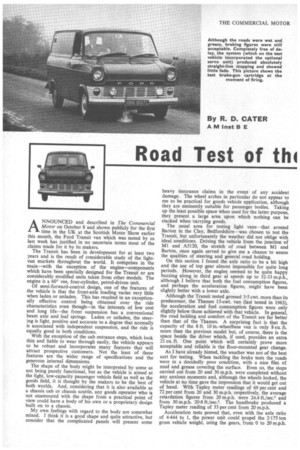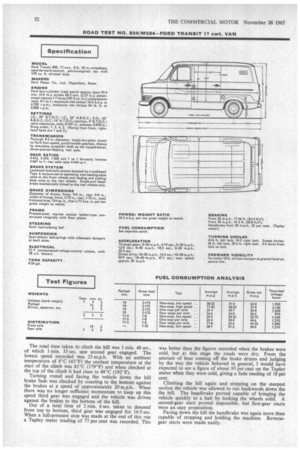Road Test of thi Ford Transit 850 Van
Page 52

Page 53

Page 54

If you've noticed an error in this article please click here to report it so we can fix it.
ANNOUNCED and described in The Commercial Motor on October 8 and shown publicly for the first time in the UK at the Scottish Motor Show earlier this month, the Ford Transit van which was tested by us last week has justified in no uncertain terms most of the claims made for it by its makers.
The Transit has been in development for at least two years and is the result of considerable study of the lightvan markets throughout the world. It comprises in the main—with the exception of the engine—components which have been specially designed for the Transit or are considerably modified units taken from other models. The engine is a 600 vee, four-cylinder, petrol-driven "unit.
Of semi-forward-control design, one of the features of the vehicle is that the front-axle loading varies very little when laden or unladen. This has resulted in an exceptionally effective control being obtained over the ride characteristics even though—in the interests of low cost and long life—the front suspension has a conventional beam axle and leaf springs. Laden or unladen, the steering is light, positive and accurate to a degree that normally is associated with independent suspension, and the ride is equally good in both conditions.
With the exception of the cab entrance steps, which look thin and liable to wear through easily, the vehicle appears to be robust and incorporates many features that will attract prospective customers. Not the least of these features are the wider range of specifications and the generous internal dimensions.
The shape of the body might be interpreted by some as not being purely functional, but as the vehicle is aimed at the light, low-capacity passenger vehicle field as well as the goods field, it is thought by the makers to be the best of both worlds. And, considering that it is also available as a chassis cab or chassis scuttle, any goods operator who is not enamoured with the shape from a practical point of view could have a body of his own or a proprietary design•built on to a chassis.
My own feelings with regard to the body are somewhat mixed. I think it is a good shape and quite attractive, but consider that the complicated panels will present some heavy insurance claims in the event of any accident damage. The wheel arches in particular do not appear to me to be practical for goods vehicle application, although they are eminently suitable for passenger bodies. Taking up the least possible space when used for the latter purpose, they present a large area upon which nothing can be stacked when 'carrying goods.
The usual area for testing light vans—that around Barton in the Clay, Bedfordshire—was chosen to test the Transit, but unfortunately the weather did not oblige with ideal conditions. Driving the vehicle from the junction of M1 and A5120, the stretch of road between M1 and Barton, once again served to give me a chance to assess the qualities of steering and general road holding.
On this section I found the axle ratio to be a bit high and the use of top gear almost impossible for quite long periods. However, the engine seemed to be quite happy buzzing along in third gear at speeds up to 32-33 m.p.h., although I believe that both the fuel consumption figures, and perhaps the acceleration figures, might have been slightly better with a lower axle.
Although the Transit tested grossed 3.5 cwt. more than its predecessor, the Thames 15-cwt. van (last tested in 1963), the acceleration and fuel consumption figures were only slightly below those achieved with that vehicle. In general, the road holding and comfort of the Transit are far better than that of the Thames. A surprising fact is that the capacity of the 8 ft. 10 in.-wheelbase van is only 8 Cu. ft. more than the previous model but, of course, there is the space beside the driver which, if used, provides an extra 21 cu. ft. One point which will certainly prove more acceptable and reliable is the floor-mounted gear change.
As I have already hinted, the weather was not of the best sort for testing. When tackling the brake tests the roads were in a decidedly poor condition, with a nice film of mud and grease covering the surface. Even so, the stops carried out from 20 and 30 m.p.h. were completed without any anxious moments and, although the wheels locked, the vehicle at no time gave the impression that it would get out of hand. With Tapley meter readings of 69 per cent and 72 per cent from 20 and 30 m.p.h. respectively, the average retardation figures from 20 m.p.h. were 24.4 ft./sec.2 and from 30 m.p.h. 20.8 ft./sec.2. The handbrake produced a Tapley meter reading of 33 per cent from 20 m.p.h.
Acceleration tests proved that, even with the axle ratio of 4.444 to 1, the power unit could propel the 2.175 ton gross vehicle weight, using the gears, from 0 to 20 m.p.h. in 6.15 sec.; from 0 to 30 m.p.h. in 12 sec.; 0 to 40 m.p.h. in 18.2 sec.; and 0 to 50 m.p.h. in 32.5 sec. Direct-drive tests were not at all bad when it is considered that the maximum speed in third gear proved to be 61 m.p.h. and in top gear 81 m.p.h. From 10 m.p.h. in top gear, 20 m.p.h. was reached in 16-3: 30 m.p.h. in 30.9; and 40 m.p.h. in 47.1 sec.
During this test I felt that the vehicle was extremely unhappy below about 28 m.p.h. in top gear. In fact, a . pronounced knock could be heard between 10 and 12 m.p.h. and the transmission was extremely rough. This reinforced my view that the axle ratio was on the high side, for round-the-houses work at least. And this was confirmed when making the four-stops-per-mile fuelconsumption tests, because on numerous occasions I was unable to get into top gear until the speed had reached almost 30 m.p.h.—when, of course, it was time to stop again.
Again the need for operators to be extremely careful when specifying axle ratios was highlighted. When I broached the subject with the Ford engineer who accompanied me on the test he was in full agreement and said that the company hoped that customers would be advised by their Ford dealers as to which axle was best for their purposes.
At 60 m.p.h. Average
The high-speed test, completed on M1 between A505 and A557, was—as in other recent tests on this section—made in two parts. The run north over the distance of 11 miles was completed with almost no baulking and without releasing the throttle from the " flat-out " position. Taking 11 min. 1 sec. and retuning an average speed of 60 m.p.h., the van gave a consumption of 17-25 m.p.g.
On the run south I was baulked for a distance of just over two miles, when the road speed was reduced to 49 m.p.h. at the worst point. Taking 11 min. 30 sec. and returning an average speed of 57.2 m.p.h., the fuel consumption worked out at 16.8 m.p.g. Thus, a mean average speed of 58.55 m.p.h. and a mean average fuel consumption of 17.02 m.p.g. were returned over 22 miles of motorway.
Running non-stop not exceeding 40 .m.p.h. and averaging about 30 m.p.h., it will be seen in the fuel-consumption panel that there is little difference in the results whether the vehicle is laden, half-laden or empty. In fact, through a slight delay caused by a parked vehicle on the empty non-stop run, the result turned out to be slightly worse than that produced by the half-laden test. Main road driving in the Transit van can only be compared with private car motoring. The 4.5 kW. heater is extremely effective in keeping the whole of the interior of the vehicle at a comfortable working temperature. A remarkably efficient defroster will keep the screen completely free of snow in extremely bad conditions and the wiper equipment—which, like the mirrors, has been specially designed for the vehicle—clears a sensibly placed, large area of screen.
A standard fitting, the screen washers have two double jets which are designed to spray the screen at the most effective positions to obtain a quick clearance of road dirt and film. The special design of the wiper blades proved necessary because standard types lifted off the screens when the vehicle reached certain speeds or when the wind was blowing strongly.
The hill-climb test was carried out on Bison Hill, near VVhipsnade. This hill is 0.75 miles long and has an average gradient of 1 in 10 and a steepest gradient of 1 in 6.5. The performance of the vehicle was such that whilst second gear was the lowest used, it was also the highest for nearly all the distance; only for 15 sec. at the very top was third gear engaged. (Continued overleaf)
The total time taken to climb the hill was 1 min. 48 sec., of which 1 mm. 33 sec. saw second gear engaged. The lowest speed recorded was 23 m.p.h. With an ambient temperature of 8`C (43°F) the coolant temperature at the start of the climb was 81°C (179°F) and when checked at the top of the climb it had risen to 88°C (192°F).
Turning round and facing the vehicle down the hill brake fade was checked by coasting to the bottom against the brakes at a speed of approximately 20 m.p.h., When there was no longer sufficient momentum to keep up this speed third gear was engaged and the vehicle was driven against the brakes to the bottom of the hill.
Out of a total time of 2 min. b sec. taken to descend from top to bottom, third gear was engaged for 16-5 sec. When a full-pressure stop was made at the end of this run a Tapley meter reading of 77 per cent was recorded. This was better than the figures recorded when the brakes were cold, but at this stage the roads were dry. From the amount of heat coming off the brake drums and judging by the way the vehicle behaved in general, I would have expected to see a figure of about 95 per cent on the Tapley meter when they were cold, giving a fade reading of 18 per cent.
Climbing the hill again and stopping on the steepest section the vehicle was allowed to run backwards down the the hill. The handbrake proved capable of bringing the vehicle quickly to a halt by locking the wheels solid. A second-gear start proved impossible, but first-gear starts were an easy proposition. Facing down the hill the handbrake was again more than capable of stopping and holding the machine. Reversegear starts were made easily.
















































































































